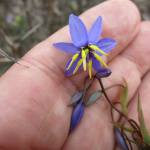There’s an awful lot going on, and all of it’s good, all of it’s about participating in Life with a capital L.
A couple of hours ago I got a text message from a nurse at Prof Harnett’s clinic. The entire text message was just two digits: a one and a zero. Ten. Ten! Brilliant! My lucky number relates to my CA125 level, an indicator of possible ovarian cancer activity. High numbers bad, low numbers good. Ten is a lovely low number.
In the run-up to this blood test I kept myself pantingly busy working on the 200 Plants and Animals exhibition which opened last Friday night. We had about 50 people at the launch. The exhibition, whipped into aesthetic line by Cate McCarthy, looked fabulous at about 4pm on Friday evening. Two hours to spare! I even had time to go home and have a shower and put a skirt on.
The exhibition is all about paying attention to where we live. Which is in a planetary system that appears robust but is actually caving, crumbling, subsiding, declining, getting warmer, losing bits of itself. The exhibition (which continues until 5pm next Sunday) explores the bit of the system that we’re inhabiting right here, right now – focusing on non-human living things. A hundred local plants, a hundred local animals all feature in the exhibition. The largest thing is the skull of a horse; the smallest is a tiny, tiny dead beetle. It includes my own bit of amateur biologising: a pressed dandelion from the back yard, and crocheted human brains (humans are included but only as the “one hundreth animal”). There’s a spotted marsh frog painting by the Hazzards; Mum’s pobblebonk; my friend Kirsty Lewin’s black cockatoo mask; lots of photos by Tim Bergen; bright pastels by Johannes Bauer who is both ecologist and artist; Ray Mjadwesch’s specimens including the dried remains of a sugar glider that died after being snarled in barbed wire; our old dog Taro; a glass-art cat with a chain saw. Mostly native animals and plants, but a few introduced species that share this habitat.
Working on this exhibition with the BCCAN committee and others in the team, my sense of this planet as a teeming, rich-in-every-corner thing has grown. I got angry with an ad for Mortein on television the other night. It seemed incredible to me that wholesale scorched-earth policies in private homes are allowed, willy nilly, along with anti-bacterial hand washes. Good to have in hospitals, but the idea of daily life in disinfected spaces now seems a lesser life.
Which brings me to Matt Damon on Mars with his potato plants fertilised by human dung. There he is in a superhuman struggle against the basic facts of life: our bodies were created and are supported by our one and only planet, with its air and water and animals and plants and seasons and sea and earth. And he wins. He works out how to “science the shit out of” his dire situation. The movie brims with an eager love of science, of figuring things out, trying things out, failing and trying again. I enjoyed that. It was also a long paean to NASA. I’m as much a fan of NASA as the next person, or maybe even more, having grown up next to one of the tracking stations that tracked the Gemini and Apollo missions.
But in these days of climate change and environmental destruction, such enthusiasm over humanity’s ability to shuck off the demands of our slow-evolving nature just makes me a little sad for us and for the planet we’re buggering up in the process. There we are, soiling our own nest, just waiting to take flight, get off into outer space, colonise distant planets, all in close-fitting Star Trek suits.
On television a few days later, there was the lame Revenge of the Sith, in which the vibrant world of the original Star Wars movie was oddly reduced to a cross between daytime soap and a computer game for kids. It was all smooth surfaces and whizzing things. Where were these beings growing their food, disposing of their waste? Where was biology in all this? (Okay, just Googled it. Star Wars does have its own biological objects and rules, according to Wookieepedia.) When James Cameron’s Avatar came out, I thought it might have been the beginning of a different type of futurism, one that explored the idea of living sustainably within an ecosystem. But Avatar was a one-off. The future, as imagined by Hollywood, still has a Jetsons quality (it’s the future, and you never see the Earth’s surface, let alone a single tree).I love science as much as the next person, or even more, having so far been saved by modern medical knowledge. But the idea that we can “science the shit out of” our environmental problems, including climate change, will not work on its own. I think it needs to be united with a profound acceptance of – and interest in – the limitations and workings of our own bodies and our own planet.

sorry – not an orchid – you’ve got a lily there in your pic. sounds like a terrific idea for an exhibition theme.
True! A Lily! Thanks for that. 🙂
So glad Taro was included. A magnificent soulful being. ( and so glad about the ten!) x
Congratulations on the Little One Zero!
Yeah, sciencing the shit out of our plants and animals often forgets those bumps and textures that make up living life. Those winged, feathered, scaled and furred, and the leafed, barked and celled. The growing breathing whole cacophany of life that we so very easily overlook or turn away from.
Happy 10. Happy 200. You are a wonderful 100th animal!